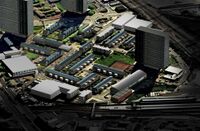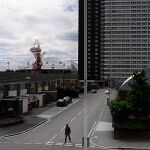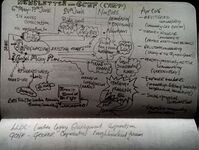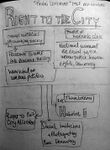LED 2016 Group C Landscape Democracy Challenge 3
Carpenter's Estate, Olympic Site, Stratford, London, Hidden Challenges
| Place name | Carpenters Estate | |
| Location | London, E15 | |
| Country | UK | |
| Author(s) | Daniela Ellis | |

| ||
Rationale: Why have you chosen this case for the landscape and democracy seminar?
- Why is this case relevant?
- ‘Everything we see hides another thing, we always want to see what is hidden by what we see.’- Rene Magritte
This is not about Residents against Demolition or anti-development movement to prevent progress, but a meaningful conversation about the impact of political decisions and the impact of privatising public land (change of ownership). How does a change affect the future of the city in relation to the Right to the city. A well located Carpenters Estate is adjacent to the Olympic development site, Stratford International Rail Station, and Stratford City Westfield Shopping District. This story is about the offloading public assets, shifting wealth, and the links of this movement to the global movement of the Right to the City. How do they all affect eachother? Could the community protect the ownership of public land? What are the options here? In conversation with the Local Tenants Association, called CARP in 2012, now known as Greater Carpenters Neighbourhood Forum, we further research we listen how does the community perceive the whole situation. In a supported interview document, I have included the original conversation with the former chair of the CARP.
Representation of your observations
- The Interview:
An email sent to 110 residents of Carpenters Estate stated the matter in which they would be addressed for the purposes of getting the full story in perspective. One person responded, it was the ex-chair of the tenants association, a contact which I found in my inbox from our previous correspondence back in 2012.
I have now been looking into the Global movement of the Right to the City and reading various articles which relate to the movement, to find on ground level a warm-hearted relation to the notion of social movement emerging through the cities around the world which challenges the quality of urban life in broader context. A movement for local residents and businesses whom have gather to protect the community assets and challenge the means of public land and further use of existing urban fabric.
The Estate was build 1968 and Tenants Management was established in 1997. 2004, announcement for demolishing one of the towers James Riley Point and decantation of tenants. In 2005, London wins the bid for the Olympic, and between 2005-09 Three Masterplans are presented to increase density of the site from 75 units per ha to 220 units per ha. In 2010 stakeholder workshops and public meetings are organised by the Newham Council.
The GCNF (Greater Carpenters Neighbourhood Forum) story is slightly different starting with Management of their properties, the right to buy the council flats, organising the local tenants against demolition through to protecting the local community assets, and forming a Neighbourhood Forum to complying with London and Local Plan and the Planning and Community Policies. The local authorities have not shown any interest in working together with the community of the estate.
The phone rang five minutes after I sent the email to the CARP residents group (Carpenters Against Regeneration Plan) which caught me off guard to start a conversation.
Initially, the voice on the phone said: Well, a lot happened since 2012, and as you remember we worked with Just Space and LTF(London Tenants Forum) and still working with them now, but we are no longer called CARP, but Greater Carpenters Neighbourhood Forum; and I am not involved as much these days. I am tired. I still go to the meetings but other people have taken over the role of the plan. We are currently working with residents, so it complies with the London Plan, The Olympic Legacy and London Legacy Development Corporation (LLDC) as the local planning authority; and suspiciously adds ‘apparently the policies of our activities are already in our Local Plan.’
I ask: ‘What does it mean?’; he says ‘I guess we have won’; I say: ‘Won against Who?’ He said: ‘Well the developer has run out of money and they could not finish the projects they started (a French company) and now they could not demolish the buildings, so we are allowed to start a community-led plan to refurbish the towers and the lower-rise,’
Q: ‘Are you trying to get the Neighbourhood Plan together to protect public assets and remain as a social housing from becoming extinct and relating the global movement of The Right to the City?’
A: We are not trying to save the world, we are keeping it low, focus on the immediate area. We are not challenging any politics actually none of us are interested in that side.
Q: Are the local authorities working together with you?
A: They are not working with us, but they are the owner of the land. Well actually they are not the freeholder, they are Custodian, which means they should also follow policies, housing laws and have to justify their intentions; and they do not have the right to undermine human or legal rights of the local residents.
Q: Are you trying to protect the Social Housing?
A: Well, we compromise, as there is not enough motif. It should fall under affordable housing and the council's ability to offload social housing.
Q: Are the buildings fully occupied?
A: The low rise is fully occupied, the blocks are there, they are just stagnant.
Q: What is the plan?
A: The plan is to keep it as it is and refurbish the blocks and add few floors to the low rise, but most of the people living in our neighbourhood do not want to be involved, they do not even like talking about it, they are ignorant, they refuse to get connected, and the system capitalises on it.
'Here is what we have to offer you in its most elaborate form -- confusion guided by a clear sense of purpose.'- Gordon Matta-Clark
Reflection
What are the major challenges for changing the situation?
- Looking at the boundary if the Carpenters Estate, as a former industrial area, there are possible opportunities of development of brownfield land, but also the public spaces around the estate. The density of the former estate was 75 units per ha, and the proposed development for the site has increased density 220units per ha. Why do people decide to move here? This is a site that was selected and appointed for building the Olympic Facilities back in 2005, and since then Westfield Shopping Centre, one of the biggest shopping zones in London has been built, as well Stratford Internation,Eurostar London-Paris; and Stratford- Stanstead; and Stratford-City Airport, good international connectivity, attractive for city workers on high income. However, the Carpenters Estate had predominantly residents on low-income and the decantation started, for the purpose of displacing the current residents. Owners were offered basic deals, in shining leather folders, 10 times less the value of the land at the time. This is what the authorities had to offer the public, consultation in how they would be moved elsewhere; due to the regeneration plan and demand for more housing. My interest in the site comes from analysing boundaries, and ownership.Watching how those boundaries and ownership are shifting and changing due to the regeneration. The change is structure of local authorities, new local authorities in place, like the London Legacy Development Corporation (LLDC), change in ownership of community assets and what does it mean? change of management for the site and shifting of public funds; changes in local policies- neighbourhood forum. How much of these future changes are affecting the current community, are they empowering? do they at all benefit the current communities?
What could be a starting point for democratically-based change?
- Protect the interest of people on low-income and allow small business to prosper from current changes. If the area is becoming wealthier, how could this influence certain people to do better; or how could small business and low-income residents take part and directly be involved and engaged? Could possible public assets be protected by setting up local trusts, co-ops etc to protect and manage the same on behalf of the local community? Is there enough existing skill and finance to pursue such demand? How to ensure that affordable housing is fair and applicable to local residents; how affordable really is? Incorporate joined banking, waste management and good delivery for small businesses; integrate schemes for positive recycling, sharing language and skill programmes, public art and events, as well as green energy programmes with community shares.
References
- http://greater-carpenters.co.uk/
- carp-newsletter-1
- carp-newsletter-2
- https://www.bartlett.ucl.ac.uk/dpu/programmes/postgraduate/msc-social-development-practice/in-practice/london-based-fieldwork/carpentersreport
- https://www.youtube.com/watch?v=vjyLWMSZ2nY
- http://www.mckinsey.com/global-themes/urbanization/urban-world-mapping-the-economic-power-of-cities
- http://www.uclg-cisdp.org/en/right-to-the-city/world-charter-agenda
- https://en.wikipedia.org/wiki/United_Cities_and_Local_Governments
- http://www.theguardian.com/cities/2016/apr/19/right-city-social-movement-transforming-urban-space
- https://www.habitat3.org/the-new-urban-agenda
- http://homesforall.org/about/
- http://www.theguardian.com/world/2013/mar/04/corrala-movement-occupying-spain
- https://www.newham.gov.uk/Pages/ServiceChild/The-Carpenters-Estate-Stratford.aspx
- HowtoHousingCo-op6theditionJuly2011low-res
- A nomadic war machine in the metropolis
- Habitat_III_National_Reporting_Processes_-1
- UCLG_Global_Charter_Agenda_HR_City_0
- Please make sure that you give proper references of all external resources used.
- Do not use any images of which you do not hold the copyright.
- Please add internet links to other resources if necessary.
About categories: You can add more categories with this tag: "", add your categories







